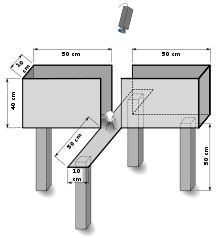- Elevated plus maze
-
 An elevated plus maze for mice
An elevated plus maze for mice
The elevated plus maze (EPM) is a rodent model of anxiety that is used as a screening test for putative anxiolytic or anxiogenic compounds and as a general research tool in neurobiological anxiety research.
Contents
Method
The test setting consists of a plus-shaped apparatus with two open and two enclosed arms, each with an open roof, elevated 40–70 cm from the floor. The model is based on rodents' aversion of open spaces. This aversion leads to the behavior termed thigmotaxis, which involves avoidance of open areas by confining movements to enclosed spaces or to the edges of a bounded space. In EPM this translates into a restriction of movement to the enclosed arms.[1][2][3][4]
Anxiety reduction in the plus-maze is indicated by an increase in the proportion of time spent in the open arms (time in open arms/total time in open or closed arms), and an increase in the proportion of entries into the open arms (entries into open arms/total entries into open or closed arms). Total number of arm entries and number of closed-arm entries are usually employed as measures of general activity (see[5]). The relation between the EPM and other tests of exploratory activity (open-field and emergence) have been analyzed in two mouse strains.[6]
Validity
While EPM is the most commonly employed behavioral animal anxiety model, there are several issues concerning the validity of the model. Classical clinical anxiolytics, such as benzodiazepines (e.g., Valium), do reduce measures of anxiety in EPM. However, more novel compounds, such as 5-HT1A agonists (e.g., Buspar) give mixed results. Selective serotonin reuptake inhibitors and tricyclic antidepressants, which are commonly employed in clinical settings to treat anxiety disorders, also do not lead to a stable anxiolytic effect on EPM.[4] This raises the possibility that EPM is a suitable model for testing GABA-related compounds, such as benzodiazepines or direct GABAA agonists, but not for other drugs. Despite this, the model is commonly employed for screening putative anxiolytics and for general research into the brain mechanisms of anxiety,[7] because of the ease of employment and the vast number of studies already in the literature. An alternative explanation to the lack of correlation between this model and treatments for the purportedly related DSM-IV conditions is that the psychopharmacological paradigm relating to these conditions is flawed.
See Also
References
- ^ Pellow S, Chopin P, File SE, Briley M. Validation of open:closed arm entries in an elevated plus-maze as a measure of anxiety in the rat. J Neurosci Methods 1985;14:149–67.
- ^ Treit D, Menard J, Royan C. Anxiogenic stimuli in the elevated plus-maze. Pharmacol Biochem Behav 1993;44:463–9.
- ^ Rodgers RJ. Animal models of anxiety: where next? Behav Pharmacol 1997;8:477–96.
- ^ a b Carobrez AP, Bertoglio LJ. Ethological and temporal analyses of anxiety-like behavior: the elevated plus-maze model 20 years on. Neurosci Biobehav Rev 2005;29:1193–205.
- ^ Hogg S. A review of the validity and variability of the elevated plus-maze as an animal model of anxiety. Pharmacol Biochem Behav 1996;54:21–30.
- ^ Lalonde, R; Strazielle C (2008). "Relations between open-field, elevated plus-maze, and emergence tests as displayed by C57/BL6J and BALB/c mice.". Journal of Neuroscience Methods 171 (1): 48–52. PMID 18358538.
- ^ Engin E, Treit D. The effects of intra-cerebral drug infusions on animals' unconditioned fear reactions: A systematic review. Prog Neuro-Psychopharmacol Biol Psychiatry 2008, doi:10.1016/j.pnpbp.2008.03.020
Categories:- Research methods
Wikimedia Foundation. 2010.

